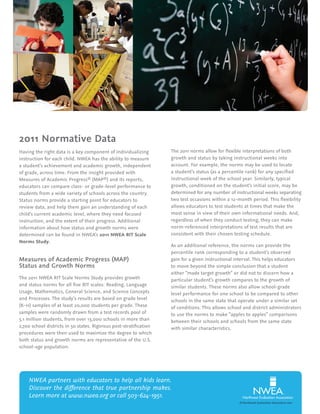More Related Content
Similar to 2011 normative data_overview-1
Similar to 2011 normative data_overview-1 (20)
2011 normative data_overview-1
- 1. 2011 Normative Data
Having the right data is a key component of individualizing
instruction for each child. NWEA has the ability to measure
a student’s achievement and academic growth, independent
of grade, across time. From the insight provided with
Measures of Academic Progress®
(MAP®
) and its reports,
educators can compare class- or grade-level performance to
students from a wide variety of schools across the country.
Status norms provide a starting point for educators to
review data, and help them gain an understanding of each
child’s current academic level, where they need focused
instruction, and the extent of their progress. Additional
information about how status and growth norms were
determined can be found in NWEA’s 2011 NWEA RIT Scale
Norms Study.
Measures of Academic Progress (MAP)
Status and Growth Norms
The 2011 NWEA RIT Scale Norms Study provides growth
and status norms for all five RIT scales: Reading, Language
Usage, Mathematics, General Science, and Science Concepts
and Processes. The study’s results are based on grade level
(K-11) samples of at least 20,000 students per grade. These
samples were randomly drawn from a test records pool of
5.1 million students, from over 13,000 schools in more than
2,700 school districts in 50 states. Rigorous post-stratification
procedures were then used to maximize the degree to which
both status and growth norms are representative of the U.S.
school-age population.
The 2011 norms allow for flexible interpretations of both
growth and status by taking instructional weeks into
account. For example, the norms may be used to locate
a student’s status (as a percentile rank) for any specified
instructional week of the school year. Similarly, typical
growth, conditioned on the student’s initial score, may be
determined for any number of instructional weeks separating
two test occasions within a 12-month period. This flexibility
allows educators to test students at times that make the
most sense in view of their own informational needs. And,
regardless of when they conduct testing, they can make
norm-referenced interpretations of test results that are
consistent with their chosen testing schedule.
As an additional reference, the norms can provide the
percentile rank corresponding to a student’s observed
gain for a given instructional interval. This helps educators
to move beyond the simple conclusion that a student
either “made target growth” or did not to discern how a
particular student’s growth compares to the growth of
similar students. These norms also allow school-grade
level performance for one school to be compared to other
schools in the same state that operate under a similar set
of conditions. This allows school and district administrators
to use the norms to make “apples to apples” comparisons
between their schools and schools from the same state
with similar characteristics.
NWEA partners with educators to help all kids learn.
Discover the difference that true partnership makes.
Learn more at www.nwea.org or call 503-624-1951.
©Northwest Evaluation Association 2011
- 2. In the samples, each district’s base school calendar was used to
determine instructional days. Using the instructional days data,
time frames for beginning-of-year tests, middle-of-year tests, and
end-of-year tests were established. The centers of these time frames
were roughly 20 days, 80 days, and 130 days from the beginning of
the academic year of the student’s school for the fall, winter and
spring terms, respectively.
2011 READING STATUS NORMS (RIT VALUES)
Grade
Beginning-of-Year
Mean
Middle-of-Year
Mean
End-of-Year
Mean
k 142.5 151.0 157.7
1 160.3 170.7 176.9
2 175.9 183.6 189.6
3 189.9 194.6 199.2
4 199.8 203.2 206.7
5 207.1 209.8 212.3
6 212.3 214.3 216.4
7 216.3 218.2 219.7
8 219.3 221.2 222.4
9 221.4 221.9 222.9
10 223.2 223.4 223.8
11 223.4 223.5 223.7
2011 MATHEMATICS STATUS NORMS (RIT VALUES)
Grade
Beginning-of-Year
Mean
Middle-of-Year
Mean
End-of-Year
Mean
k 143.7 150.7 159.1
1 162.8 172.4 179.0
2 178.2 185.5 191.3
3 192.1 198.5 203.1
4 203.8 208.7 212.5
5 212.9 217.8 221.0
6 219.6 222.8 225.6
7 225.6 228.2 230.5
8 230.2 232.8 234.5
9 233.8 234.9 236.0
10 234.2 235.5 236.6
11 236.0 237.2 238.3
2011 LANGUAGE USAGE STATUS NORMS (RIT VALUES)
Grade
Beginning-of-Year
Mean
Middle-of-Year
Mean
End-of-Year
Mean
2 175.4 185.3 190.0
3 191.1 196.5 200.3
4 200.9 204.4 207.0
5 208.0 211.0 212.9
6 212.3 214.4 216.2
7 215.8 217.3 218.7
8 218.7 220.2 221.3
9 220.6 221.0 221.8
10 221.9 222.2 222.7
11 222.1 222.7 223.3
2011 GENERAL SCIENCE STATUS NORMS (RIT VALUES)
Grade
Beginning-of-Year
Mean
Middle-of-Year
Mean
End-of-Year
Mean
3 189.0 192.5 195.5
4 196.4 198.7 200.8
5 201.3 203.7 205.3
6 205.4 206.8 208.1
7 208.2 209.5 210.9
8 211.2 212.4 213.5
9 213.2 213.6 214.3
10 214.9 215.6 216.2
2011 SCIENCE CONCEPTS STATUS NORMS (RIT VALUES)
Grade
Beginning-of-Year
Mean
Middle-of-Year
Mean
End-of-Year
Mean
3 188.0 191.7 194.5
4 195.4 197.5 199.5
5 200.6 202.8 204.3
6 204.6 205.9 207.1
7 207.5 208.7 209.9
8 210.4 211.5 212.4
9 213.2 213.6 214.3
10 213.9 214.3 214.6
